Description of a Modern Whale Hunt
After being chased to exhaustion, the whale is shot with a grenade tipped harpoon before it is winched aboard
the whaling ship dead or alive.
Introduction
In the 21st century, whaling is big game hunting under a different name. It reveals the savage side of
man when the thin veneer of civility is removed. Hunting whales is not necessary for human survival or for whale
products. Whaling it is not necessary to conserve another species, fish or ecosystem.
The technology used for killing whales has altered little since the 16th and 19th century, The grenade tipped
harpoon has been used for over 100 years. It is an imprecise weapon that relies on shrapnel and blast within the
harpooned whale to cause death. In reality, death is rarely instantaneous and it can reportedly take up to 130 minutes for the
whale to die.
The grenade harpoon is a primitive contraption that has no place in the 21st century as a humane way of killing a
whale. So inefficient is this weapon that a range of other means are used in efforts to extinguish its life.
Unlike fish, who can dive and disappear, whales need to surface to breathe. Moreover, whales have not evolved as
a prey species and are therefore not adapted to being chased or fighting back. This article by
Sonar explores why whales and dolphins do not fight back against their human tormentors.
Today, the full extent of their suffering is yet to be scientifically evaluated. However, man is capable of
imagining how another mammal may suffer whether it be a whale, wild animal, domestic pet or farm animal. Moreover,
the visual evidence of a harpooned whale thrashing around in the ocean clearly shows that it does suffer. The
question still remains if a whale is still alive long after it has been judged to be dead.
A report published in 2004 on the welfare implications of modern whaling entitled Troubled Waters concludes, "On grounds of animal welfare alone,
therefore, all whaling operations should be halted." Today, there is no meaningful regulation to protect the welfare
of whales. The regulations governing whaling as a whole are ignored by the whaling industry because there is
virtually no enforcement. Consequently, whaling continues in spite of a world-wide ban introduced in 1986.
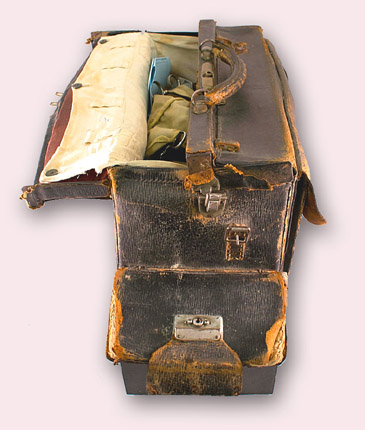
Image courtesy RCPSG
Medical bag of Dr Harry Lillie
enlarge
Dr Harry Russell Lillie - probably the first crusader for whales
The Royal College of Physicians and Surgeons of Glasgow recently received a donation of a medical bag belonging
to Dr Harry Lillie, together with a copy of his book The Path through Penguin City (1955). Dr Lillie was a
surgeon and medical officer aboard British whaling ships in the Antarctic during the 1940's. Within his book, he
describes the horrors of whaling:
“If we can imagine a horse having two or three explosive spears stuck in its stomach and being made to pull
a butcher’s truck through the streets of London while it pours blood into the gutter, we shall have an idea of the
method of killing. The gunners themselves admit that if whales could scream the industry would stop, for nobody
would be able to stand it.”
In his memoir, Dr Lillie makes note of a post-war world in which the killing of animals: “encompassed more
and more the hell to which the ambitions of men can lead”. In this regard, he believed, a nation was:
"... just as much an aggressor if with wanton cruelty it attacks the other creatures that share this earth with
us. As a breed we have the most vile sins... We hunt creatures to death, after first making sure they are
weak enough not to be able to hurt us in return. And we fire mutilating explosives into whales in the name of big
business"
Whales and other cetaceans, dolphins and orcas, certainly do express pain in terms that humans with empathy can
immediately relate to. Recently, in 2018, a US travel blogger recounted her experience when she came upon 146
beached whales on a remote New Zealand beach. Being alone and waiting for help, she recalls "I'll never forget
their cries, the way they watched me as I sat with them in the water, how they desperately tried to swim but their
weight only dug them deeper into the sands". Her story was reported by BBC news on 27 November 2018.
The modern whale hunt
A whale is normally located by the whaling boat's sonar. According to observers of the Japanese Minke whale
hunts, it's typical for a catcher boat to pursue a whale for 30 minutes, or much longer, in order for the gunner to
get within twenty to thirty yards of the targeted whale.
A book published on 2 June 1995 by Roger Payne entitled Among Whales (pg 258) quotes 'Whalers quickly discovered
that a frequency of three thousand hertz seemed to panic the whales, causing them to surface much more often for
air, This was a “better" use for sonar because it afforded the whalers more chances to shoot the whales. So they
equipped their catcher boats with sonar at that frequency. Of course the sonar also allows the whalers to follow the
whale underwater, but that is its secondary use. Its primary use is for scaring whales so that they start “panting”
at the surface.'
The whale may try to dive or hide but to no avail. Many whales are so struck with fear that they defecate
which turns the water a deep orange which in turn reveals their location.
The pursuit itself often causes physical and psychological stress, which may lead to fatal syndromes such as
Exertional Myopathy, a condition that scientists believe may prove fatal, even to animals that evade capture.
Below is footage of illegal Japanese whaling in a southern ocean whale sanctuary filmed by customs officials of
the Australian Government . . .
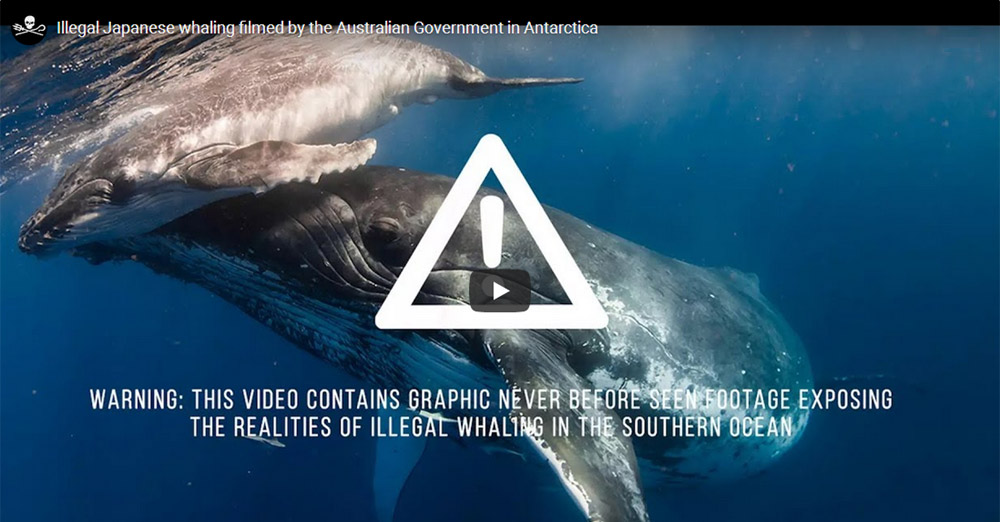
Footage of illegal Japanese whaling in a southern ocean whale sanctuary filmed by customs officials of the
Australian Government
The grenade harpoon cannon
The grenade harpoon comprises a shaft with rope attached and the end secured to an onboard winch motor. The front
of the harpoon is tipped with a penthrite grenade followed by 4 retracted steel claws (hooks). The harpoon is fired
under explosive discharge from a deck mounted cannon located on the prow of the vessel.
When a shot is fired, the harpoon leaves the cannon at a velocity of around 90 - 100 metres per second. When hit,
the harpoon penetrate the whales' body to a depth of 30 cm, or more, before the grenade explodes. As a rule, the
harpoon goes straight through a Minke whale after the grenade has detonated. Detonation and/or tension on the
harpoon rope causes the claws to deploy and the whale is 'hooked'.
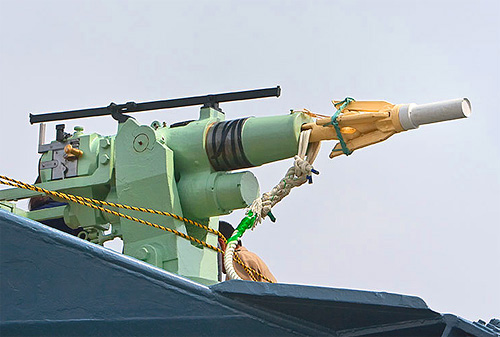
Grenade Harpoon Cannon of the Japanese Whaling Ship Yushin Maru
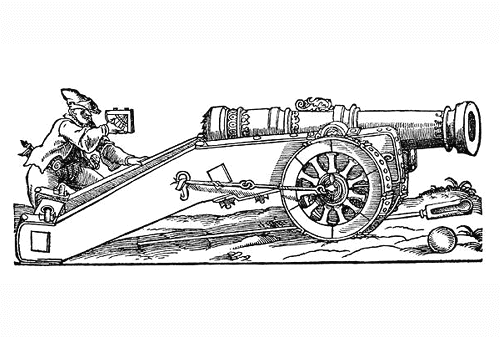
16th Century Cannon
A critically important part of grenade harpoon cannon technology has not changed much from the 16th century. The
harpoon gunner sights the whale along the barrel of the cannon, albeit along a sighting bar. This form of sighting a
target was typically used by cannon gunners in the 16th century. It is totally inadequate for the necessary
precision sighting in the 21st century, to even attempt an inhumane stun, or kill of a whale.
The closer the harpoon strike is to the brain, then the quicker the whale is immobilised. However, the target
area is relatively small for a moving ship at sea and there are too many variables to ensure a humane kill,
including: bent harpoon, poorly maintained cannon, ships motion: heave, sway, surge, roll, pitch and yaw. The whale
too has its own motions. The ideal angle of the shot cannot be chosen, poor visibility etc. When all of these
variables are combined, then an instantaneous humane kill is unlikely.
Time taken for a harpooned whale to die
The method used for killing a whale out-of-sight at sea would not be tolerated by man for the slaughter of a
mammal on land.
The grenade tipped harpoon is intended to cause 'immobilisation' by exploding inside the whales' body
causing:
- Blast-generated pressure waves causing neurotrauma (brain and spinal chord damage)
- Flying shrapnel from the blast causing damage to vital organs
Massive trauma, damage to vital organs, nerves and internal bleeding causes the whale to thrash and writhe around
in agonising pain and suffering. Tension on the rope causes the harpoon claws to expand and anchor deeper into the
whales' body causing even more pain and suffering.
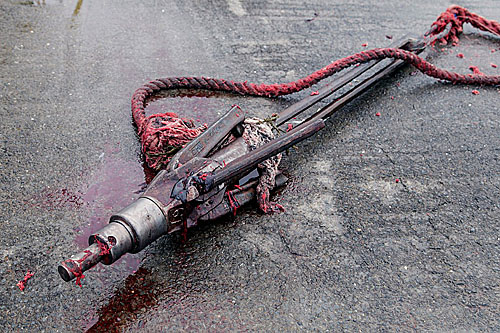
Credit: Arnaldur Halldorsson/Bloomberg
Detonated grenade tipped harpoon
after being cut-out from a fin whale
enlarge
Norway reported that 81% of Minke
whales were killed "instantaneously" during the 2002 hunt. Japan's Antarctic Minke whale hunt in 2002/2003
reported 40% killed "instantaneously." That means, from Japan's own statistics, that 60% of whales did not die
immediately and a secondary killing means would have been required.
Currently, there is no scientific evidence that whales shot with a grenade harpoon die immediately. The growing
consensus is that the whale is stunned, immobilised or unconscious, but not dead.
The time it takes for a whale to die is a secret and the whaling nations will not reveal the data as this report shows and this
article from the Reykjavík Grapevine.
A report by the International Fund for Animal Welfare (IFAW) found that more than 80% of whales are not killed
instantly once harpooned. This is due to the lack of ability of harpoon gunners to hit the area close to the
whale’s brain. Once harpooned, whales are often alive when they are winched into the hunting ship with the harpoon
embedded into their flesh, causing severe suffering. Many whales that are winched in alive, do not die from the
blow of the harpoon, but of suffocation, with their blow holes forced under water by the process of winching them
in.
Data reviewed on Minke whale deaths between 1983 and 2000 revealed that the longest time for an animal to
die was about 90 minutes for Norway, and (according to one author) 130 minutes for Japan.
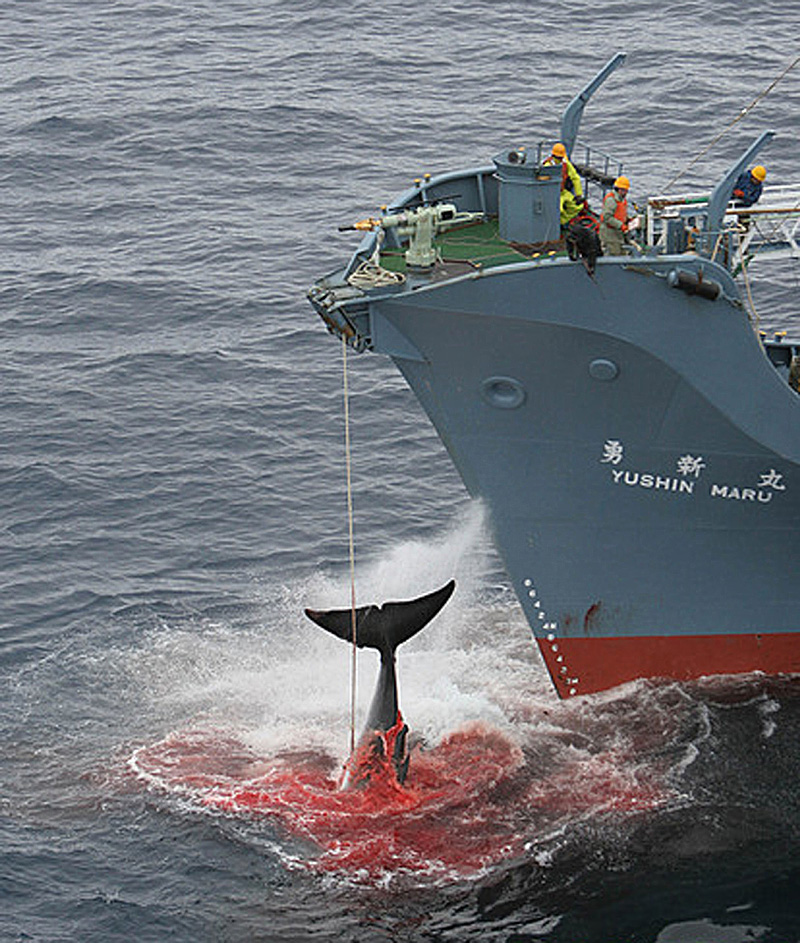
Japanese whaling ship Yushin Maru
Restricted target kill area of Minke whale
A paper published by the School of
Veterinary Science, University of Bristol states that 'An alternative design of grenade is used by the Japanese and
historically the rate of immediate ‘stun’ in Japanese hunts has been substantially lower than the Norwegian hunts
(Kestin 1999). Although the Norwegian design of grenade has always outperformed that of the Japanese, the
Japanese have been reluctant to switch because of the increase in cost (Anon 2003)'. Note: the cost of a Norwegian
grenade is around $600.
The study was based on 69 Minke whales shot and killed by two Norwegian boats using penthrite grenade harpoons.
In this sampling, 3 whales were harpooned twice and 3 whales suffered no internal detonation because one harpoon
misfired and two harpoons passed through the bodies of the whales. Therefore the study results were based on 63
Minke whales.
Of the 63 whales shot, the figure below shows the impact sites that resulted in immediate immobilisation and
impact sites that did not. From the concluding words of the study 'the question of whether an immediately immobile
whale is stunned remains'.
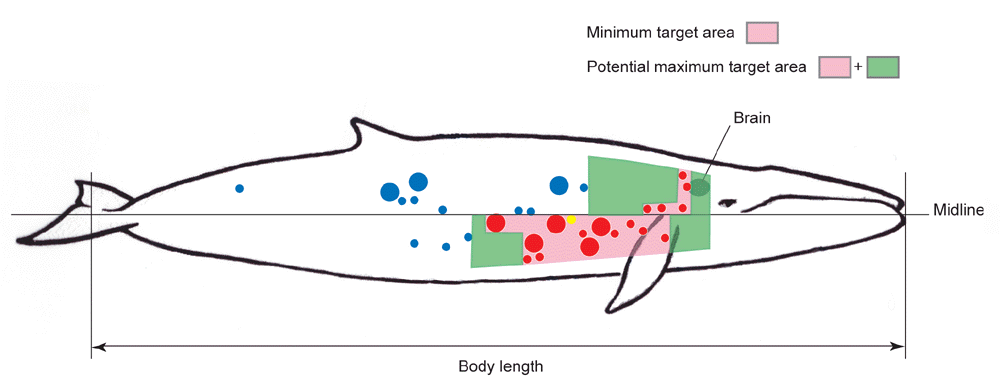
Impact sites that resulted in immediate immobilisation are shown in red, impact sites that did not, are shown
in blue. Large marks indicate a cluster of five impact sites and small marks, a single impact site.
The impact areas above are based on Norwegian gunners marksmanship whereas the marksmanship and methods of
Japanese gunners is considerably less accurate.
The image below shows a typical 'impact' area, although the grenade has not exploded. Kristjan Loftsson, the multimillionaire owner of
Iceland's Hvalur hf, examines the unexploded grenade and considers how best to deal with it.
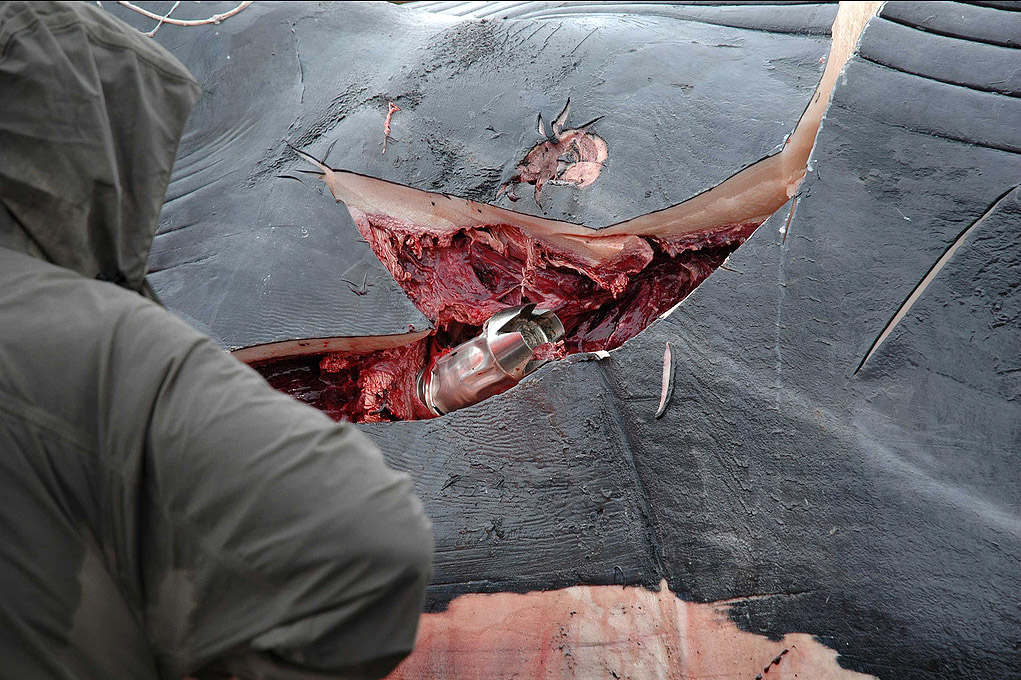
Unexploded harpoon grenade embedded in whale
enlarge
Japanese grenades are less than 50% efficient, detonating inside the whales in only 1,310 of 2,758 animals hit in
1983/84. The fuses were developed for large whales, and most grenades which do not explode within the whale do so in
the water after the harpoon has passed right through its body
For Japan’s 2001/2002 hunt in Antarctica, out of 440 whales, 55 were struck again with a harpoon and 301 shot by
rifle (the average number of shots per whale was 2.2
It is likely that the inefficiency of the Japanese grenade is intentional in order to minimise damage to needed
body parts and meat. A report entitled Japanese
Whaling Strategies states "It appears that Japanese whalers use minimum amount of explosives in order to preserve as
much whale meat as possible.*
An informative report entitled 'Hunted Dead or
Alive' shows that Japanese harpoon gunners deliberately avoid the whale’s head in order not to damage the fragile
“ear-plugs” which they collect as part of the study that supports their claim to be conducting ‘scientific whaling’.
[note: Ear wax accumulates throughout the life of a whale and amongst other things, reveals the stress that it has
encountered. A recent study reveals that during the whales' lifetime, they were particularly stressed by the
activities of man.]
Dr Steve Kestin, of the department of clinical veterinary science at Bristol University has reported that there is evidence showing that
nearly half the animals hit by Japanese whalers are struck in a region which would not lead to rapid death.
Secondary Killing Methods
If the first harpoon fails to immobilise the whale, then a second penthrite harpoon or rifle may be used as a
secondary killing method. The common use of secondary methods reflects the inefficiency of current whale killing
practices.
In their paper 'The Fallacy of Humane
Killing', the Humane Society of the United States refers to the use of the electric lance: The Japanese have
used this “secondary” method of killing after using an explosive harpoon on a whale. Because explosive harpoons
damage much of the muscle (meat) in the area of impact, whalers are reluctant to use two grenades on one whale when
death is not instantaneous. A whale who survives an explosive harpoon strike is dragged back to the ship and secured
alongside it. An electric charge is then shot through the whale, which is supposed to induce instant death. However,
the voltage of the electric charge is insufficient to cause immediate death (even when applied directly through the
brain or heart) and merely adds to the whale’s torture and agony. The Japanese claim to have ceased use of the
electric lance in response to concerns about humaneness, but without international observers, if and under what
circumstances it continues to be used are impossible to verify
Because of its massive size and its complex vascular system, it can take a long time for a whale to die. It takes
time for the brain to become depleted of oxygen or for the whale to bleed to death. As the whale thrashes around or
tries to dive to evade the horror, some whaling fleets may use an old fashioned cold harpoon as a secondary weapon.
These so called cold harpoons have been banned by the IWC since 1981 as they were deemed too cruel. These harpoons
did not use explosives but just consisted of sharp barbs which dug in to the animal's body, this was particularly
cruel as it took the whale approximately 5 to 8 excruciating hours to die.
Instant death is never guaranteed and an IWC report concluded that 2 out of every 16 whales die from
asphyxiation. This happens when the whale is harpooned in the tail area. When it is hauled out of the water its head
and blow hole are submerged and therefore the whale suffocates and drowns.
As it is very difficult to gauge whether a whale is dead or not due to the fact that they can store a vast
amounts of oxygen in their internal organs, sometimes the whale is winched on to the factory boat still alive.
Approximately 60% of all females caught are pregnant, usually the baby or fetus will die shortly after the mother
or else it will be brutally killed. All of the mentioned methods of capturing and killing run counter to the humane
slaughter and animal welfare standards as laid down by the World Organization for Animal Health, which is an
intergovernmental organisation responsible for improving animal health. Not only does it have 172 member nations but
it is also recognised as a reference organisation by the World Trade Organization (WTO).
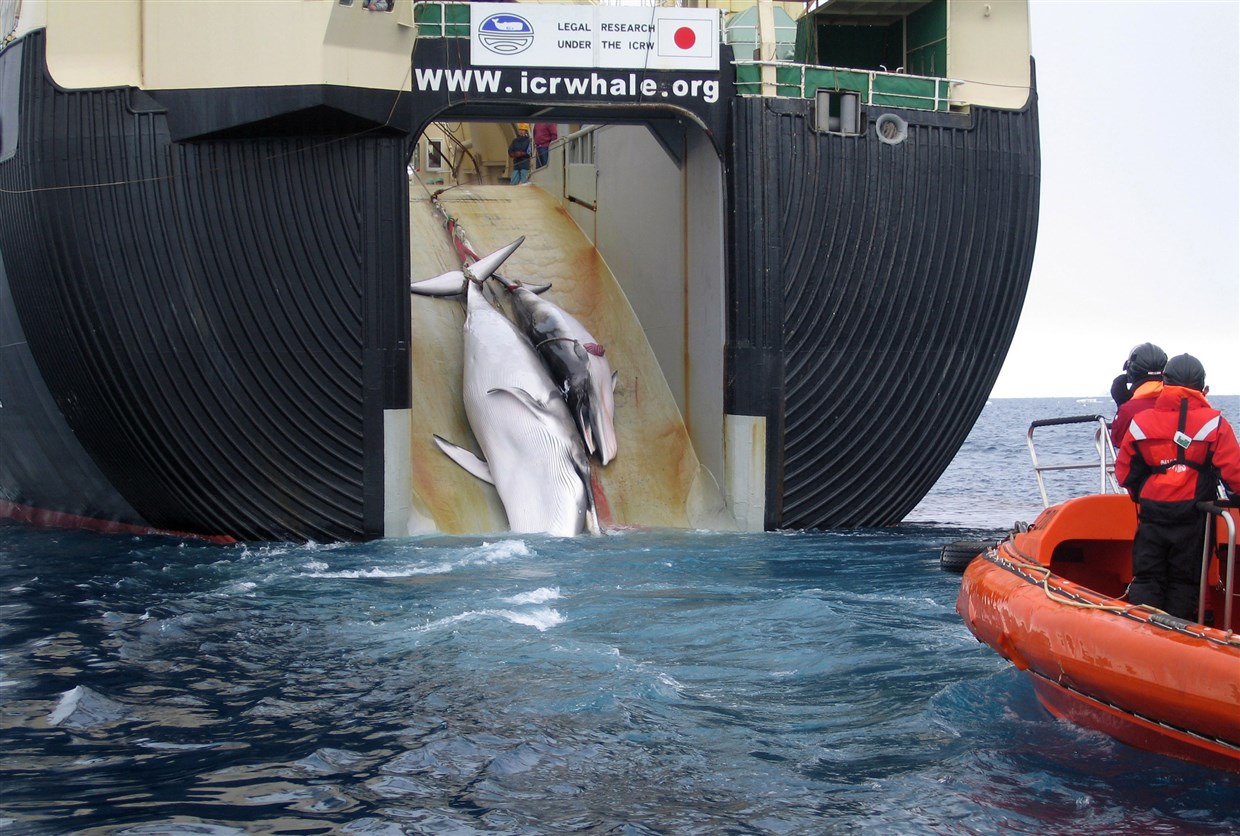
Credit: Australian Customs Service
Minke whale and her calf are hauled aboard the Japanese harpoon ship Yushin Maru 2
'Struck & lost' whales
In addition to the captured whales, there are a significant number that are categorised as “struck and lost”;
whales that have either been hit by a harpoon or shot but have managed to escape. These animals can incur a wide
range of injuries, such as bleeding and damage to internal organs. They may be so badly injured that they may have
difficulty in feeding or breeding, or may die from their wounds., but it may take days or even weeks for that to
happen as they endure a slow agonising death. Whether caught or lost, the suffering is not only limited to the whale
itself but the entire pod suffers emotionally and physically as these creatures are very social and have close
relationships with one another.
Major welfare concerns
A stressful pursuit, prolonged times to death, and some animals being struck and lost, add up to a major welfare
problem for whales, of which we may not yet know the full extent. The physiological adaptations of cetaceans to the
marine environment have significant implications for their welfare. For example, adaptations for diving and going
without oxygen intake for long periods, make it difficult to determine when the animal is dead. Whales may therefore
survive and experience pain over a period significantly longer than suggested by the current IWC criteria for death
in whales. This begs the question, are some whales still alive when hauled onto the whaling ship for flensing? This
issue is further discussed in the WDC report Hunted Dead or 'Still'
Alive..
During the 1999 IWC Workshop on Whale Killing Methods, one expert noted that ‘causing humane death without pain
in meat animals usually includes the induction of instantaneous insensibility by stunning. Instantaneous in this
context is embodied in European Union Legislation which requires a limit of about 100 milliseconds between stimulus
(application of stunning device) and unconsciousness. The figure of 100 milliseconds is based on the pain perception
delay of 100 to 150 milliseconds found in meat animals.’
Clearly, modern whaling techniques do not come close to delivering ‘death without pain, stress or distress’. All
current whaling methods include a chase and, even in hunts where more powerful killing weapons are used,
irreversible insensibility or instantaneous death – the key to a humane kill – is still not achieved in a
significant number of cases.
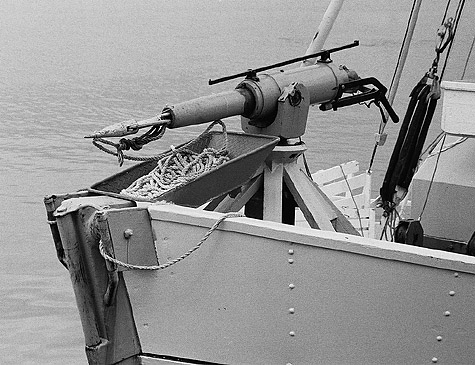
Cold harpoon on the prow of the Norwegian fishing trawler Balaenoptera
enlarge
Experts at a NAMMCO workshop raised concern that Japan still uses a non-exploding (‘cold’) harpoon – as a secondary killing method for coastal Minke whales and for sei whales if the first harpoon does not kill the whale.
In 1981 the IWC banned the cold harpoon because, designed to secure and wound whales rather than kill them outright, it was just too cruel. However, cold harpoons were persistently used to hunt minke whales in Norway until 1984. It was the use of the cold harpoon during a Norway whaling probe that led to the creation of the Environmental Investigation Agency.
This paper provides some background into the Norweigan minke whale killing methods.
The cold grenade harpoon has either an empty grenade casing or a simple iron pointed head. The use of
non-explosive (cold) weapons prolong the whale’s agony, and hunters have to resort to other, more cumbersome methods
to complete the kill.
Use of the cold harpoon is grossly inhumane but the benefit to the whaler is the cost saving in not using a
grenade and the recovery of meat less damaged by blast and shrapnel. Also, the whale is caught - which would appear
to be the only consideration. Whales harpooned this way do not die from the impact and penetration of the harpoon
but will bleed to death in a slow and agonising way.
Norway have been reportedly used the cold harpoon as a primary killing means. It would appear that the Japanese
whalers have also been using cold grenades as a primary means. In reality, these are not 'killing' means but brutal
'catching' means.

Masayuki Komatsu
Former Japan Fisheries Agency chief
enlarge
A paper entitled 'Why Japan Supports
Whaling', shows that whales are usually considered a type of fish, rather than a mammal. This view is reflected
and reinforced in Japan’s 1500-year-old writing system, in which the symbol for whale (pronounced kujira) includes
within it a component that means fish (uo-hen).
Considering whales as fish, many Japanese lack any special love of whales and disagree with Western animal rights
activists who insists on whales’ rights During an interview in 2001,
The paper also refers to the Japan Fisheries Agency chief Masayuki Komatsu referring to Minke whales as
“cockroaches of the ocean, because there are too many ...”
It would appear that the Japanese whaling industry have no regard, empathy or humanity for whales which may
suggest the use of the cold harpoon as a primary killing method, as has already been demonstrated by Norwegian whale
hunters.
Bloody business
In an article for 'Outsidemag', Philip Armour writes, "When I decide to try and get on a Norwegian whaleboat,
I had no illusions about solving the whaling issue. I just wanted to understand it better, by meeting the whalers
and getting a clear look at what they do and how they justify it." You can read the article about his time
aboard the whaleboat Sofie here
























